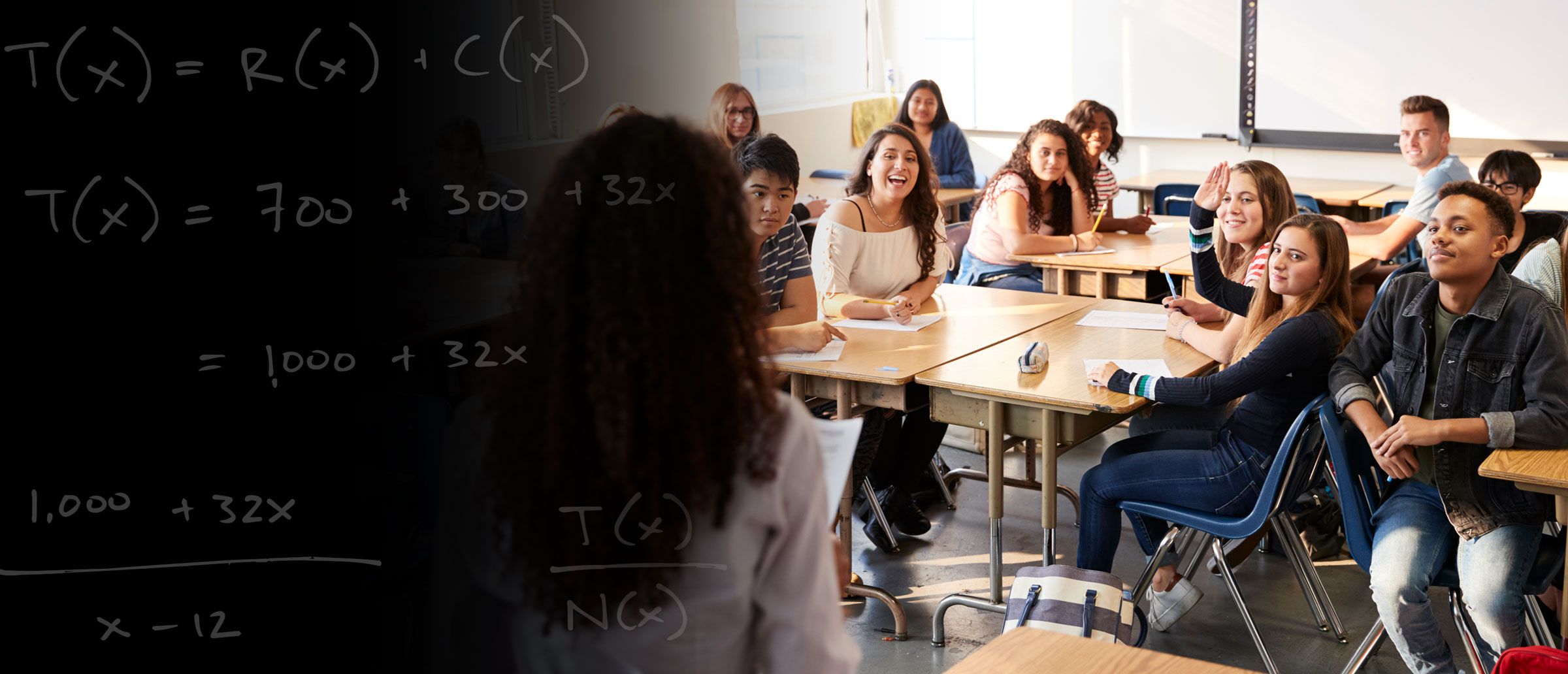
Elimination (Lesson 2.3)
Unit 1: Sequences and Linear Functions
Day 1: Recursive Sequences
Day 2: Applications of Arithmetic Sequences
Day 3: Sum of an Arithmetic Sequence
Day 4: Applications of Geometric Sequences
Day 5: Sequences Review
Day 6: Quiz 1.1 to 1.4
Day 7: Linear Relationships
Day 8: Point-Slope Form of a Line
Day 9: Standard Form of a Linear Equation
Day 10: Quiz 1.5 to 1.7
Day 11: Unit 1 Review
Day 12: Unit 1 Test
Unit 2: Linear Systems
Day 1: Linear Systems
Day 2: Number of Solutions
Day 3: Elimination
Day 4: Larger Systems of Equations
Day 5: Quiz 2.1 to 2.4
Day 6: Systems of Inequalities
Day 7: Optimization Using Systems of Inequalities
Day 8: Quiz 2.5 to 2.6
Day 9: Unit 2 Review
Day 10: Unit 2 Test
Unit 3: Function Families and Transformations
Day 1: Interpreting Graphs
Day 2: What is a function?
Day 3: Translating Functions
Day 4: Quiz 3.1 to 3.3
Day 5: Quadratic Functions and Translations
Day 6: Square Root Functions and Reflections
Day 7: Absolute Value Functions and Dilations
Day 8: Equations of Circles
Day 9: Quiz 3.4 to 3.7
Day 10: Unit 3 Review
Day 11: Unit 3 Test
Unit 4: Working with Functions
Day 1: Using Multiple Strategies to Solve Equations
Day 2: Solving Equations
Day 3: Solving Nonlinear Systems
Day 4: Quiz 4.1 to 4.3
Day 5: Combining Functions
Day 6: Composition of Functions
Day 7: Inverse Relationships
Day 8: Graphs of Inverses
Day 9: Quiz 4.4 to 4.7
Day 10: Unit 4 Review
Day 11: Unit 4 Test
Unit 5: Exponential Functions and Logarithms
Day 1: Writing Exponential Functions
Day 2: Graphs of Exponential Functions
Day 3: Applications of Exponential Functions
Day 4: Quiz 5.1 to 5.3
Day 5: Building Exponential Models
Day 6: Logarithms
Day 7: Graphs of Logarithmic Functions
Day 8: Quiz 5.4 to 5.6
Day 9: Unit 5 Review
Day 10: Unit 5 Test
Unit 6: Quadratics
Day 1: Forms of Quadratic Equations
Day 2: Writing Equations for Quadratic Functions
Day 3: Factoring Quadratics
Day 4: Factoring Quadratics. Part 2.
Day 5: Solving Using the Zero Product Property
Day 6: Quiz 6.1 to 6.4
Day 7: Completing the Square
Day 8: Completing the Square for Circles
Day 9: Quadratic Formula
Day 10: Complex Numbers
Day 11: The Discriminant and Types of Solutions
Day 12: Quiz 6.5 to 6.9
Day 13: Unit 6 Review
Day 14: Unit 6 Test
Unit 7: Higher Degree Functions
Day 1: What is a Polynomial?
Day 2: Forms of Polynomial Equations
Day 3: Polynomial Function Behavior
Day 4: Repeating Zeros
Day 5: Quiz 7.1 to 7.4
Day 6: Multiplying and Dividing Polynomials
Day 7: Factoring Polynomials
Day 8: Solving Polynomials
Day 9: Quiz 7.5 to 7.7
Day 10: Unit 7 Review
Day 11: Unit 7 Test
Unit 8: Rational Functions
Day 1: Intro to Rational Functions
Day 2: Graphs of Rational Functions
Day 3: Key Features of Graphs of Rational Functions
Day 4: Quiz 8.1 to 8.3
Day 5: Adding and Subtracting Rational Functions
Day 6: Multiplying and Dividing Rational Functions
Day 7: Solving Rational Functions
Day 8: Quiz 8.4 to 8.6
Day 9: Unit 8 Review
Day 10: Unit 8 Test
Unit 9: Trigonometry
Day 1: Right Triangle Trigonometry
Day 2: Solving for Missing Sides Using Trig Ratios
Day 3: Inverse Trig Functions for Missing Angles
Day 4: Quiz 9.1 to 9.3
Day 5: Special Right Triangles
Day 6: Angles on the Coordinate Plane
Day 7: The Unit Circle
Day 8: Quiz 9.4 to 9.6
Day 9: Radians
Day 10: Radians and the Unit Circle
Day 11: Arc Length and Area of a Sector
Day 12: Quiz 9.7 to 9.9
Day 13: Unit 9 Review
Day 14: Unit 9 Test
Learning Targets
Solve linear systems using elimination.
Use elimination strategies to determine if a system has 0, 1, or infinite solutions.
| Tasks/Activity | Time |
|---|---|
| Activity | 20 minutes |
| Debrief Activity with Margin Notes | 10 minutes |
| QuickNotes | 10 minutes |
| Check Your Understanding | 10 minutes |
Activity: How Much is a Taco?
Lesson Handouts
Media Locked
Media Locked
Answer Key
Media Locked
Homework
Media Locked

Experience First
The goal of this lesson is that students use their problem solving skills to solve linear systems without a step-by-step procedure. Instead we want them thinking about how would they actually figure this out if they were Jacob or Amala. The questions were written with that in mind. It is our hope that students won't jump to graphing in their calculators or to solving with substitution. While they could do that, this system is actually much faster to solve without those methods, which is one of the reasons we like elimination. Sometimes it's a lot simpler than other methods. So as students are working, keep in mind that we are trying to get them to see what the simplest way to solve is. Question 2b really gets at this. What are the differences in the orders? Ask students, "What more did Jacob and Amala get? How much more did they pay?" Question 3 is going to be tougher for students. We want them to notice that they can double or triple Amala's order so that she has the same number of slices or cannolis as Jacob. So how do we get them to see that? You'll want to be ready with your guiding questions. Also, multiple groups may have this same question so trying to help a couple groups at a time can keep the class moving. Guiding Questions:
Formalize Later
The margin notes for this lesson are really cool because we're actually going to take the students work and show how the elimination works algebraically in the margin. So in question 1, when we ask about the differences in the orders, we're going to show how that is taking one equation and subtracting the other. That leaves us with an equation that we can solve because now we have one resulting equation with one variable. Now that we know one variable, we can solve for the other. As you're debriefing the rest of the activity, try to highlight as many different approaches as possible. You may even ask multiple groups to write their solutions to the same problem on the board if they solved it in a different way. For example, some students might solve question 3c by eliminating the slices of pizza while others may have eliminated the cannolis. One last thing...the last Check Your Understanding problem is modeled after a practice SAT item. These types of questions are VERY common on the SAT, and while students could find the correct answer by plugging in an answer choice and solving the system, they will save a lot of time if they notice the structure in the system and that we want coefficients that are multiples of each other.